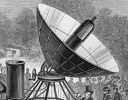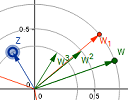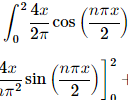IntMath Newsletter: Solar vision, GeoGebraTube
By Murray Bourne, 10 Dec 2014
10 Dec 2014
In this Newsletter:
1. Math teacher's solar vision
2. Resource: GeoGebraTube
3. Best of 2014
4. Comparison of Web math publishing options
5. Math puzzles
6. Final thought - success
Issues in last edition
a. Improvements in crosswind landing app: I realized after sending out the last mail that there were some errors in the cross-wind landing applet. On some tablets, the Cessna would fly around in crazy loops. These issues are fixed now. Please always let me know if something doesn't work, or look right, on IntMath.
b. Canadian Thanksgiving: I'd like to apologize to my Canadian readers for saying in the last IntMath Newsletter that Canadian Thanksgiving is at the same time as it is in the USA. In Canada, it's actually celebrated on the second Monday in October.
1. Math teacher's solar vision
 |
There were solar powered engines long before oil-based ones. Here's a story about French mathematics teacher Augustin Mouchot, who invented one. |
2. Resource: GeoGebraTube
Last Newsletter I gave a brief overview of new features in the powerful math visualization app, GeoGebra.
 |
Here's a great resource if you are starting out in GeoGebra: It contains over 100,000 ready-made worksheets for exploring mathematics concepts, made by teachers and students. |
You can interact with these worksheets online at GeoGebra, or download them to modify as you wish in your own copy of GeoGebra.
Here are some of the popular worksheets:
3. In case you missed out: Best of 2014
It's that time of year when we reflect on what it was all about.
Here are the top IntMath Newsletter articles of 2014, based on visitor counts:
20 GIFs that teach you science concepts (since disappeared)
When does log(x - 3) equal log x - log 3?
Normal Distribution Graph Interactive
Arc Length of a Spiral around a Paraboloid
I hope you enjoy these as much as I've enjoyed brining them to you.
4. Comparison of math Web publishing options
This article is for those interested in communicating math via the Web.
 |
Publishing math on the Web can be a challenge. Here's a comparison of MathJax, ASCIIMathML, KaTeX and other math publishing solutions. |
5. Math puzzles
The puzzle in the last IntMath Newsletter asked about the difference between eln x and ln ex. The correct answer with explanation was given by Michael, Nicos, Guido, Hamid and Francis, while answers by the following people were partly correct: Gerard, Miguel, Ronak and Francisco.
New math puzzle: I received the following homework question from a reader. I usually object to this type of "pseudo-real-world" question, since it's actually not at all realistic. But I thought it would be a good end of year puzzle for the Newsletter.
Mike bought 8 chocolate bars and paid $5 with his credit card and the rest with cash. His friend bought 4 chocolate bars and $7 in candy. If both of them paid the same amount of money in cash, how much does one chocolate bar cost?
Leave your responses here.
6. Final thought - success
Thomas Edison was working on his light bulb around the same time Augustin Mouchot developed his solar engine. Edison actually formed his Edison Electric Company in the same year (1878) that Mouchot exhibited at the Universal Exhibition.
This is what Edison had to say about success:
Many of life's failures are people who did not realize how close they were to success when they gave up. [Thomas Edison]
The IntMath Newsletter will take a break over the New Year period. I hope you enjoy the holiday season, and see you again in 2015!
Until next time, enjoy whatever you learn.
See the 12 Comments below.
10 Dec 2014 at 7:25 pm [Comment permalink]
Cash Balance, b is chocolate bars:
8b - 5 = 4b + 7
b = 3
$3 per bar of chocolate
10 Dec 2014 at 9:23 pm [Comment permalink]
Again Mr. Bourne let me compliment you on producing such a high quality newsletter. Yours is the only news letter that I subscribe to.
Thank you very very much for producing such valuable content for math tutors!
Sincerely,
Den Ducoff
10 Dec 2014 at 10:22 pm [Comment permalink]
If the $7 paid for candy and $5 paid by credit card, the difference of $2.00 paid for the four additional
chocolate bars at a price of $.50 each
11 Dec 2014 at 3:30 am [Comment permalink]
one bar costs $3
11 Dec 2014 at 4:23 am [Comment permalink]
@Den: Thank you for your kind comment! I'm glad you find the IntMath Newsletter useful.
11 Dec 2014 at 8:33 am [Comment permalink]
Let X cost of bar, cc the amount paid on credit card, then
For Mike;
8X = cash + cc = cash + 5, so
cash = 8X - 5 ......(1)
Friend;
cash = 4X + 7 ........(2)
As (1) = (2)
8X - 5 = 4X +7
4X = 12
X = 3 the cost of a choc bar = Answer.
Proof. Mike 8 X 3 = 24. 5 paid by credit card, so 19 paid by cash.
Friend. 4 X 3 = 12 + 7 for candy requires 19 to be paid by cash.
Both paid same amount of cash.
11 Dec 2014 at 9:41 am [Comment permalink]
Let b be the cost of one chocolate bar, and x the total cash paid by each of the two friends. Then Mike paid 8b = 5 + x, while his friend paid altogether 4b + 7 = x. From here, 8b - 5 = 4b + 7, or b = 3.
13 Dec 2014 at 9:13 am [Comment permalink]
Dear Murray
Just a line to wish you Happy Holidays and particularly to thank you for all the great items that you make accessible through your newsletter.
Best wishes to you and all your readers for 2015.
13 Dec 2014 at 9:27 am [Comment permalink]
Let the cost of 1 chocolate bar and the amount paid in cash be $x and $c respectively.
8x = c + 8 (1)
c = 4x + 7 (2)
subs. for c from (1) in (2):
8x = (4x + 7) + 8
x = 3.75
cost of 1 chocolate bar: $3.75
13 Dec 2014 at 12:30 pm [Comment permalink]
@Suzanne: Thank you for your best wishes and all the best to you, too.
18 Dec 2014 at 10:53 am [Comment permalink]
@John: Thanks for the resource!
31 Dec 2014 at 8:25 am [Comment permalink]
Dear Mr Bourne
Be x=Mount in cash
For Mike one chocolate bar cost (5+x)/8
For his friend cost (x-7)/4
Then (5+x)/8=(x-7)/4
x=19
So Mike paid 19$ in cash
19+5=24 and 24/8=3
Every chocolate bar cost 3$
Happy new year